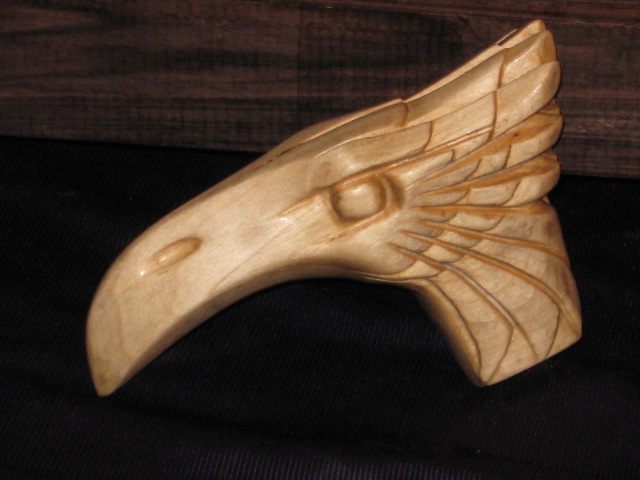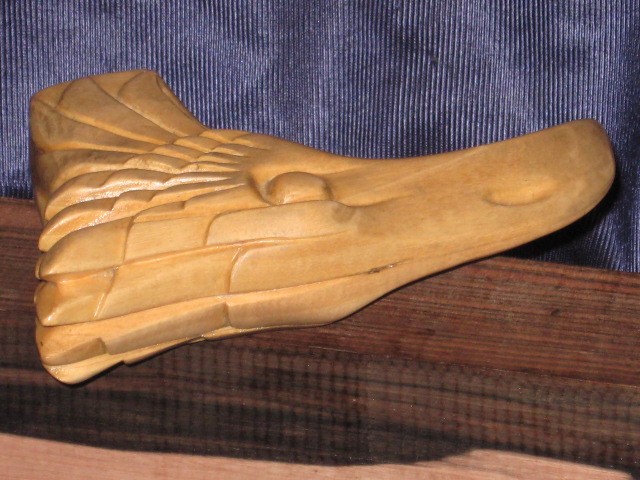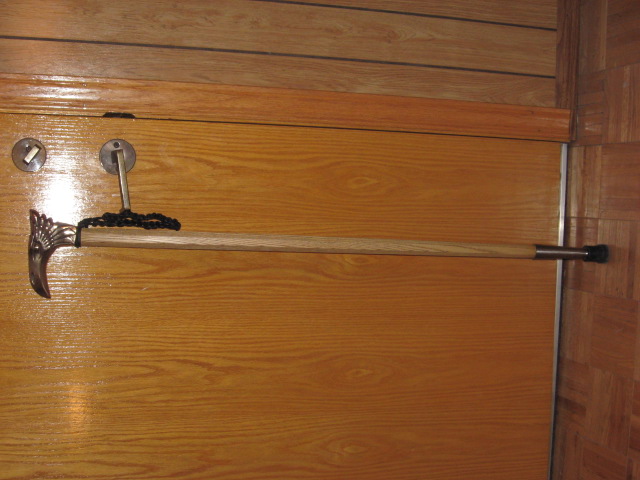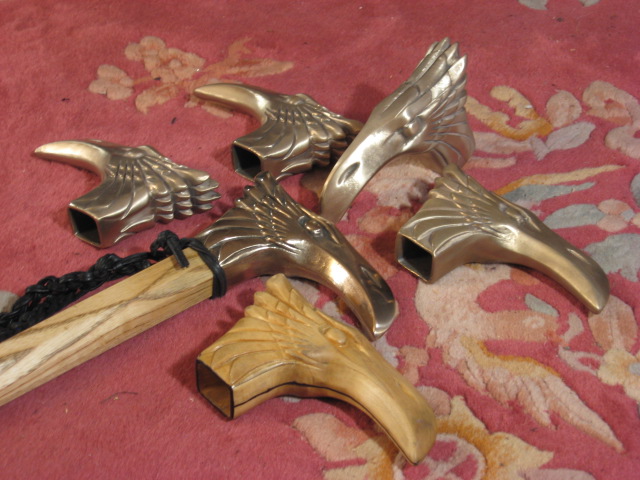| Author |
Message |
|
Dan D'Silva
|
 Posted: Tue 25 Oct, 2016 8:12 am Post subject: Everdur for blades? Posted: Tue 25 Oct, 2016 8:12 am Post subject: Everdur for blades? |
 |
|
Hello all.
I was thinking of taking foundry again next semester and maybe making a bronze sword if the professor will allow it. He says that the course uses Everdur, C.D.A. No. 873, 95 percent copper, 4 percent silicon, 1 percent manganese. Is this a decent material for a blade of about a foot long? I recall that when I was de-gating sculptures last year, it seemed very easy to cut and grind.
|
|
  |
 |
|
Timo Nieminen
|
 Posted: Tue 25 Oct, 2016 2:32 pm Post subject: Re: Everdur for blades? Posted: Tue 25 Oct, 2016 2:32 pm Post subject: Re: Everdur for blades? |
 |
|
| Dan D'Silva wrote: | | I was thinking of taking foundry again next semester and maybe making a bronze sword if the professor will allow it. He says that the course uses Everdur, C.D.A. No. 873, 95 percent copper, 4 percent silicon, 1 percent manganese. Is this a decent material for a blade of about a foot long? I recall that when I was de-gating sculptures last year, it seemed very easy to cut and grind. |
It's soft, similar to a tin bronze with about 12% tin. High-tin alloys are much better for blades, but it might be OK.
Brinell hardnesses:
Pure copper: 44
Tin bronze, 12%: 80
Tin bronze, 20%: 170
Everdur: 85
"In addition to being efficient, all pole arms were quite nice to look at." - Cherney Berg, A hideous history of weapons, Collier 1963.
|
|
   |
 |
|
Matthew Amt
|
 Posted: Tue 25 Oct, 2016 5:26 pm Post subject: Posted: Tue 25 Oct, 2016 5:26 pm Post subject: |
 |
|
There are plenty of original blades with less than 12 percent tin! I wouldn't call it "soft" at all. If I'm remembering correctly, artifacts with over 15 percent tin are pretty uncommon. There is a Mycenaean sword that has only 4 percent, but yeah, that's pretty low!
I don't know what silicon does for hardness, though judging from Timo's list it looks decent. Certainly modern silicon bronze is one of the options used for various repros these days, though I'm thinking sheet metal items. (It would be a great step up from the yellow brass that Indian companies are stuck on!)
Matthew
|
|
   |
 |
|
Timo Nieminen
|
 Posted: Tue 25 Oct, 2016 11:24 pm Post subject: Posted: Tue 25 Oct, 2016 11:24 pm Post subject: |
 |
|
Yellow brass is only about 50 Brinell hardness; Everdur is a big improvement on that.
For Chinese bronze weapons, a lot of the early ones are 8-12% tin (later ones tend to be 15-20%, which is higher than usual for European bronze blades). So people used bronzes of similar hardness to Everdur for weapons that saw real-world use.
"In addition to being efficient, all pole arms were quite nice to look at." - Cherney Berg, A hideous history of weapons, Collier 1963.
|
|
   |
 |
|
Dan D'Silva
|
 Posted: Wed 26 Oct, 2016 8:00 am Post subject: Posted: Wed 26 Oct, 2016 8:00 am Post subject: |
 |
|
Thanks everyone.
So it sounds good. I'll pencil it into my calendar.
Here's a fun thought: The material fee pays for a certain number of pounds of metal. A dagger would use somewhere around one pound, so there's gonna be plenty left over. If I finish and sell everything else I make, the course might actually pay for itself.
|
|
  |
 |
Jean Thibodeau

|
 Posted: Fri 28 Oct, 2016 5:05 am Post subject: Posted: Fri 28 Oct, 2016 5:05 am Post subject: |
 |
|
Remember also that the edges of copper based blades or bronze where work hardened at the edges before being given a final sharpening.
What I don't know is how the edge work hardening is done and when one knows when to stop hammering before the edges becomes too brittle or breaks off.
If you do hammer harden the edges you might be able to sharpen it to almost a razor edge, but being bronze it will dull more quickly if used to cut anything too abrasive: But a sword or dagger only needs to cut well for weapon usage and one would not use it to cut other things like a tool knife: A weapon is carried a lot but used rarely so it would remain sharp until needed.
A bronze edge probably needs to be resharpened or realigned with a steel more often than a steel knife.
You can easily give up your freedom. You have to fight hard to get it back!
|
|
  |
 |
|
Dan D'Silva
|
 Posted: Sat 29 Oct, 2016 4:10 am Post subject: Posted: Sat 29 Oct, 2016 4:10 am Post subject: |
 |
|
|
Hm... didn't think about edge-hardening. I know it's a step in finishing bronze blades, but it didn't occur to me that silicon bronze might not harden at the same rate as tin. Will have to do a bit more research.
|
|
  |
 |
Jean Thibodeau

|
 Posted: Sat 29 Oct, 2016 12:55 pm Post subject: Posted: Sat 29 Oct, 2016 12:55 pm Post subject: |
 |
|
| Dan D'Silva wrote: | | Hm... didn't think about edge-hardening. I know it's a step in finishing bronze blades, but it didn't occur to me that silicon bronze might not harden at the same rate as tin. Will have to do a bit more research. |
Just a suggestion: Before casting the actual dagger you want to make you might produce a few simple blades on which to experiment with hammer hardening of the edges. You can try to find the optimum amount of hammer blows that hardens the edges and also see what happens if you do too much hammering.
You can then use files and stones to create a finished sharp edge and you can then do some basic cutting tests on paper and cardboard to see how long the edges stay sharp.
Can you " recycle/re-melt " the Everdure test blades so as to reduce the cost when you do the casting of the dagger and not waste materials.
In period I assume that if you damaged your expensive bronze sword with deep nicks in the edges after a fight you could have the bronze recast into a new sword ? If you kept the wooden mould model you could have the same sword made over and over again and only need to add a little bit of bronze to compensate for material lost to wear or damage.
The value of the bronze in period may have been a lot greater than the costs of having the labor of having cast, work-hardened, finished and sharpened ?
You can easily give up your freedom. You have to fight hard to get it back!
|
|
  |
 |
|
Dan D'Silva
|
 Posted: Sat 29 Oct, 2016 3:53 pm Post subject: Posted: Sat 29 Oct, 2016 3:53 pm Post subject: |
 |
|
It's a good idea, but I'm not certain I could convince them to let me try. They keep all the reusable scraps locked in a drawer until pour days, and you know professors sometimes feel the need to stick fast to the rules.
I don't think I could cast a blade just for testing. The pours are a group effort and each item adds a lot of work that everyone has to help with. Plus each mold takes a couple weeks out of only a four-month semester and uses up some of the limited amount of slurry. Test-hardening would probably have to be on scraps of a suitable size and thickness, if there happen to be any around.
|
|
  |
 |
|
Arne G.
|
 Posted: Sat 29 Oct, 2016 6:50 pm Post subject: Posted: Sat 29 Oct, 2016 6:50 pm Post subject: |
 |
|
| Dan D'Silva wrote: | It's a good idea, but I'm not certain I could convince them to let me try. They keep all the reusable scraps locked in a drawer until pour days, and you know professors sometimes feel the need to stick fast to the rules.
I don't think I could cast a blade just for testing. The pours are a group effort and each item adds a lot of work that everyone has to help with. Plus each mold takes a couple weeks out of only a four-month semester and uses up some of the limited amount of slurry. Test-hardening would probably have to be on scraps of a suitable size and thickness, if there happen to be any around. |
Would they mind if you purchased your own Everdur and brought it in? It's not that expensive.
|
|
   |
 |
Jean Thibodeau

|
 Posted: Wed 02 Nov, 2016 7:55 am Post subject: Posted: Wed 02 Nov, 2016 7:55 am Post subject: |
 |
|
| Dan D'Silva wrote: | It's a good idea, but I'm not certain I could convince them to let me try. They keep all the reusable scraps locked in a drawer until pour days, and you know professors sometimes feel the need to stick fast to the rules.
. |
Yes but fine tuning the qualities of the final piece of art is not complete if the shape of the object is the only criteria neglecting making the object both aesthetic and functional !?
So doing a hammering test on a piece or pieces of flat thin stock is part of the creative and learning process, and these pieces of scrap once you have finished your tests can be recycled exactly the same as if you didn't have them available to do the testing and be able to learn the limits of the material for a functioning piece of art ..... if function as a bronze dagger is not important why bother making it in bronze in the first place ? ...... 
You can easily give up your freedom. You have to fight hard to get it back!
|
|
  |
 |
|
Dan D'Silva
|
 Posted: Thu 03 Nov, 2016 8:50 am Post subject: Posted: Thu 03 Nov, 2016 8:50 am Post subject: |
 |
|
| Jean Thibodeau wrote: | | Yes but fine tuning the qualities of the final piece of art is not complete if the shape of the object is the only criteria neglecting making the object both aesthetic and functional !? |
Trouble is, Bucks is not at all keen on functional weapons. Their network doesn't even let you access knifemaking websites. I suspect if they allow such a project it'll be on the condition that the blades remain blunt until they leave campus. It's just about possible that I can borrow some of the school's scraps to practice, but I wouldn't count on it.
|
|
  |
 |
James Arlen Gillaspie
Industry Professional

Location: upstate NY Joined: 10 Nov 2005
Posts: 587
|
 Posted: Thu 03 Nov, 2016 8:54 am Post subject: Posted: Thu 03 Nov, 2016 8:54 am Post subject: |
 |
|
You could buy some tin fishing sinkers at someplace like Walmart and add them in during the melt. Just stir it a bit. The silicon will assure a smooth pour.
jamesarlen.com
|
|
   |
 |
|
Dan D'Silva
|
 Posted: Tue 15 Nov, 2016 7:54 am Post subject: Posted: Tue 15 Nov, 2016 7:54 am Post subject: |
 |
|
Okay, bad news. I got a reply back from the professor today, and the college definitely does not allow us to make weapons, even blunt, unfinished ones.
I might look into farming work out to a professional foundry some day in the future, but they're awfully expensive.
|
|
  |
 |
Jean Thibodeau

|
 Posted: Wed 16 Nov, 2016 12:59 pm Post subject: Posted: Wed 16 Nov, 2016 12:59 pm Post subject: |
 |
|
| Dan D'Silva wrote: | Okay, bad news. I got a reply back from the professor today, and the college definitely does not allow us to make weapons, even blunt, unfinished ones.
I might look into farming work out to a professional foundry some day in the future, but they're awfully expensive. |
As McCoy said in the last Star Trek movie " WELL THAT'S JUST TYPICAL " when he and Spock are surrounded by flying killing machines and McCoy says before " WELL AT LEAST I WONT DIE ALONE " and then Spock get beamed out leaving him alone ......
https://www.youtube.com/watch?v=bL6Mv4VVudo
Well, you are stuck with their rules, but you don't have to believe in the fairness of their rules after you leave the college and you can decide for yourself if making a bronze sword is morally correct !
On the other hand, I assume that for casting you will be making a model in wood or some other material ? You can still make the model for future use when you have the funds and " FREEDOM " to do what you like: If this is a few years in the future you can take the time to research the sword to make it as authentic a replica as you can make and lot of time to sculpt in intricate details.
You can also research how to hammer harden the edges properly and you can chose the best possible bronze matching period bronze used for the best swords.
Oh, if you did make such an authentic and desirable bronze sword I think you could make multiple copies from the original model and probably find people on this site who would be interested in buying one, this would certainly take care of the costs of having a foundry do the casting ..... although you might have to be able to front the cost and hope to recover it later if you sold some pieces.
Here is a link to a specialized in " Art Castings " foundry of International reputation for future reference.
http://fonderieart.com/en/
There is also " TOD FOUNDRY " that did some casting for me of a Bronze Eagle's head for my walking sticks.
http://www.todsstuff.co.uk/todsfoundry/index.htm
Pics of the heads I had made.
 Attachment: 83.07 KB Attachment: 83.07 KB

Wood model.
 Attachment: 123.4 KB Attachment: 123.4 KB

Wood model.
 Attachment: 93.59 KB Attachment: 93.59 KB

One head mounted on walking stick.
 Attachment: 117.6 KB Attachment: 117.6 KB

Multiple castings + wooden model + finished stick.
You can easily give up your freedom. You have to fight hard to get it back!
|
|
  |
 |
|
|

